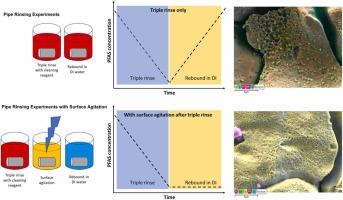当前位置:
X-MOL 学术
›
J. Hazard. Mater.
›
论文详情
Our official English website, www.x-mol.net, welcomes your
feedback! (Note: you will need to create a separate account there.)
Practical limits of current technologies in removing per- and polyfluoroalkyl substances from fire suppression systems
Journal of Hazardous Materials ( IF 12.2 ) Pub Date : 2024-11-17 , DOI: 10.1016/j.jhazmat.2024.136551 Dung Nguyen, Christopher Bellona, Adria Lau, John Stults, Hayley Andrews, David Jones, David Megson, Ian Ross
Journal of Hazardous Materials ( IF 12.2 ) Pub Date : 2024-11-17 , DOI: 10.1016/j.jhazmat.2024.136551 Dung Nguyen, Christopher Bellona, Adria Lau, John Stults, Hayley Andrews, David Jones, David Megson, Ian Ross

|
Several commercial products have been broadly marketed for their effectiveness in removing residual PFAS from AFFF-impacted fire suppression systems. However, a comprehensive assessment of their effectiveness in mitigating long-term PFAS rebound following the initial cleaning has not been reported. Herein, batch and flow-through experiments were conducted to interrogate the overall effectiveness of four different cleaning solutions in removing residual PFAS from AFFF-impacted stainless steel pipes from a fire suppression system. Advanced surface imaging techniques were also employed to correlate with bench-scale testing results and to provide insights into potential PFAS rebound mechanisms. Results presented herein demonstrate that complete removal of PFAS from AFFF-impacted fire suppression systems is extremely difficult to achieve for all four cleaning solutions examined in this study. The PFAS rebound behavior observed was likely attributable to PFAS supramolecular assemblies accumulating on the pipe surfaces. Because PFAS rebound following cleanout of AFFF-impacted fire suppression systems is likely inevitable, there needs to be an understanding of the practical limits to which impacted fire suppression system cleanout can be achieved. Improved insights into the dissolution mechanisms and the rate of dissolution of supramolecular formations will be key to improving PFAS decontamination processes and decontamination of materials/equipment impacted by AFFFs.
中文翻译:

当前技术在从灭火系统中去除全氟烷基和多氟烷基物质的实际限制
一些商业产品因其在去除受 AFFF 影响的灭火系统中残留的 PFAS 方面的有效性而得到广泛销售。然而,尚未报告对其在减轻初始清洁后 PFAS 长期反弹的有效性的全面评估。在此,进行了批量和流通实验,以询问四种不同清洁溶液在从灭火系统中去除受 AFFF 影响的不锈钢管道中残留的 PFAS 的整体有效性。还采用了先进的表面成像技术来与小规模测试结果相关联,并深入了解潜在的 PFAS 反弹机制。本文介绍的结果表明,对于本研究中研究的所有四种清洁解决方案,从受 AFFF 影响的灭火系统中完全去除 PFAS 是极其困难的。观察到的 PFAS 反弹行为可能归因于 PFAS 超分子组装体在管道表面积累。由于清理受 AFFF 影响的灭火系统后 PFAS 反弹可能是不可避免的,因此需要了解可以实现受影响灭火系统清理的实际限制。更好地了解超分子形成的溶解机制和溶解速率将是改进 PFAS 净化过程和受 AFFF 影响的材料/设备净化的关键。
更新日期:2024-11-19
中文翻译:

当前技术在从灭火系统中去除全氟烷基和多氟烷基物质的实际限制
一些商业产品因其在去除受 AFFF 影响的灭火系统中残留的 PFAS 方面的有效性而得到广泛销售。然而,尚未报告对其在减轻初始清洁后 PFAS 长期反弹的有效性的全面评估。在此,进行了批量和流通实验,以询问四种不同清洁溶液在从灭火系统中去除受 AFFF 影响的不锈钢管道中残留的 PFAS 的整体有效性。还采用了先进的表面成像技术来与小规模测试结果相关联,并深入了解潜在的 PFAS 反弹机制。本文介绍的结果表明,对于本研究中研究的所有四种清洁解决方案,从受 AFFF 影响的灭火系统中完全去除 PFAS 是极其困难的。观察到的 PFAS 反弹行为可能归因于 PFAS 超分子组装体在管道表面积累。由于清理受 AFFF 影响的灭火系统后 PFAS 反弹可能是不可避免的,因此需要了解可以实现受影响灭火系统清理的实际限制。更好地了解超分子形成的溶解机制和溶解速率将是改进 PFAS 净化过程和受 AFFF 影响的材料/设备净化的关键。


















































 京公网安备 11010802027423号
京公网安备 11010802027423号